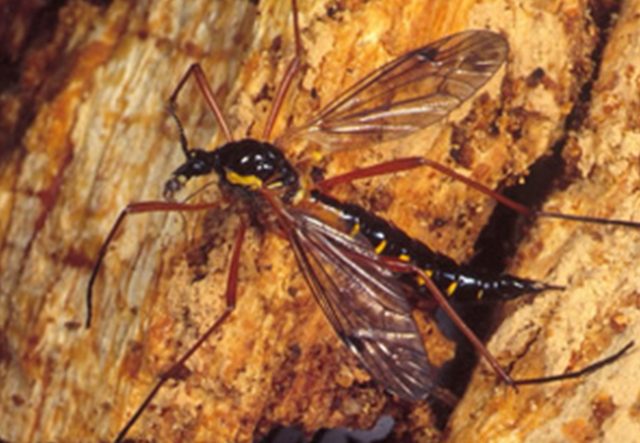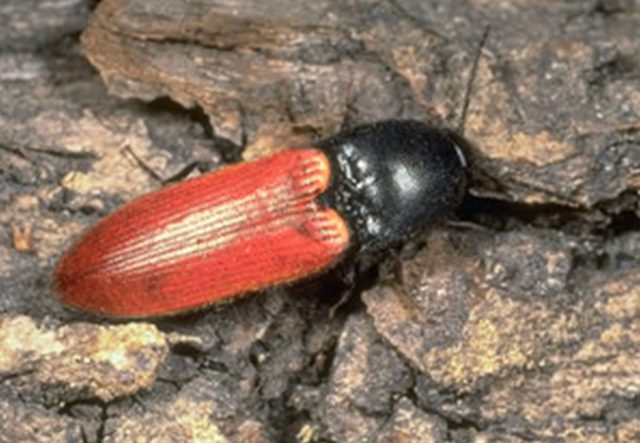Habitat Management
Retain all existing old trees wherever possible. Wood pasture and parkland differs from other woodland types in that the trees are growing in open sunny conditions. These support different invertebrate species from those growing in closed canopy woodland, so it is necessary to ensure that there is a continuum of trees standing in the open, especially mature and ancient trees. This may involve selectively thinning some younger trees in areas where denser woodland is developing.
Structural diversity is also important to provide a range of sub-habitats.
Ensure continuity of dead wood habitat
Dead wood of all ages, both standing and fallen, should be retained. The more dead wood a tree contains, the more valuable the habitat it provides in the form of a variety of different niches for a range of invertebrates. Continuity of supply of dead wood in all conditions and situations is vital because many saproxylic invertebrates need very specific conditions; moisture content can be a critical factor.
Avoid over-zealous tidying
Traditional tree-surgery techniques aimed at improving tree hygiene are not appropriate for the maintenance of trees that support invertebrate species which rely on dead wood for all or part of their life cycle. In particular:
- Standing dead wood tends to be more valuable for invertebrates than fallen timber, as it rots from the inside rather than from the outside, creating quite different conditions and microhabitats.
- Dead and rotten branches and twigs of all sizes should be retained wherever possible. If their removal is necessary for public safety, then pruning is preferable to removing the entire branch.
- Trees with top-heavy limbs such as old, neglected pollards, should be pruned in preference to removal if safety is an issue, but any work on an ancient tree should not be undertaken without careful consideration of the possible impact on the tree. Gradual reduction of the canopy over a protracted period of time, allowing regrowth to occur between treatments, is preferable to drastic reduction in just one treatment, which may result in stress or even death of the tree.
- Dead wood that is removed from a tree should be retained on site and allowed to decay in-situ as close as possible to the source. Cut and fallen wood should be left on the ground in both sunny and shaded areas to provide a variety of habitats.
- If an ancient parkland tree is blown over, the tree should be left to decay where it lies and not be removed. Tree stumps should be retained and not ground up, as species such as the Greater stag beetle (Lucanus cervus) require buried dead wood and roots in which to develop.
- Rot-holes in trees are also valuable specialist habitats required by many hoverflies and beetles. These should never be cut away, filled with concrete or chemically treated for decay. Creating new rotholes by causing damage to younger trees may be a way of ensuring continuity.
- Trees with sap runs resulting from wounds and damage such as that resulting from an attack by wood-boring beetles or the Goat moth (Cossus cossus) should be retained. Sap flows provide larval development sites for the hoverflies Ferdinandea ruficornis and Brachyopa bicolor. These sap runs should not be treated, but allowed to continue.
- Dead leaves and decaying vegetation should not be tidied away, but left undisturbed to provide potential breeding sites for fly species such as Sapromyza obsoleta and S. albiceps.
Encourage the growth of a variety of fungi
The presence of fungal growth such as bracket fungi should not be seen as a reason to remove or prune a tree, as only a minority of fungi are a primary source of tree death. Fungi not only provide an essential breeding medium for many species of flies and beetles, but they also contribute to the decay of dead heartwood in older trees. This reduces a tree’s bulk whilst leaving the living sapwood intact, which can actually make the tree better able to withstand high winds. Soft, red rotten heartwood is the sole habitat of some of our rarest and most threatened invertebrates, such as the larvae of the Violet click beetle, and very wet wood mould with a porridge-like consistency is the larval habitat for the craneflies Ctenophora ornata and Gnophomyia elsneri. Felling or removing trees with heart-rot could result in the extinction of these specialist species.
Natural fractures and jagged stumps should not be tidied or treated, as the snags will potentially allow the entry of heart-rot fungi and provide access for invertebrates.
Consider creating new deadwood niches
Management of trees to create additional deadwood habitat by ring barking selected limbs should be considered where they do not pose a health and safety risk. Creating new pollards from young trees is one way of providing more niches for saproxylic invertebrates at sites where continuity of standing dead wood is likely to be a problem. At many sites there is a large age gap between the ancient trees and any others in the area. Continuity of habitat is essential if the saproxylic fauna is to survive, as many are poor colonisers and cannot travel far to find suitable habitats.
Maintain a mixture of native tree species
The existing composition of broadleafed species at a site should be maintained, as different tree species may support a different range of invertebrates. These would normally be native trees, but some non-native species can be important to the survival of rare invertebrates. Since the loss of many elms to Dutch Elm disease, mature Horse chestnut (Aesculus hippocastanum), although non-native, has been shown to be important for species such as the hoverfly Brachyopa insensilis, and mature specimens at Moccas Park NNR are an important component of the saproxylic habitat. Where Sycamore is present, it may be providing food for insects in the form of the honeydew secreted by aphids or the scale insects that are predated on by larvae of the fly Leucopis silesiaca. Where Sycamore must be removed, this should be done sequentially over a long period (10 years) and the cut wood retained. Coppicing or pollarding should be considered instead of complete removal of the plant because the fermenting sap on the cut ends is an important microhabitat for some species of fly.
Shrubby species also have their dead-wood specialists. Dying and dead mature hawthorn is required by the Hawthorn jewel beetle (Agrilus sinusatus). Hawthorn flowers are visited by a wide range of adult flies and beetles, and the catkins of sallow and blossom of sloe are important for the early spring saproxylic hoverflies. Bramble and umbel flowers are important in the summer, and ivy is especially important for the late season hoverfly Callicera spinolae.
Maintain open areas
Open areas are essential in this habitat, providing sunny sheltered places for flowering plants and shrubs which produce the nectar and pollen required by adult flies and beetles whose larvae develop in dead wood. Suitable nectar sources include Hawthorn.
Continuing traditional management of this habitat such as low-level grazing and rotational cutting will ensure the habitat is maintained in a reasonably open state. Natural vegetational succession results in a closing of the canopy, giving more shaded conditions, which would adversely affect many of the invertebrate species on the site. Open structured woodland favours wood-ants, on which the nationally scarce chafer Cetonia cuprea depends.
Manage grazing carefully
Grazing can help to maintain a diversity of species in the sward and keeps down rank vegetation and invasive scrub. Five nationally scarce species of dung beetle are found in shady woodland conditions, all of which require the dung of large herbivores such as cows or horses and dosing livestock with broad-spectrum wormers is highly damaging to the larval development of these species. Grazing needs to be carefully managed as it is important to retain a range of flowering herb and shrub species and tussocky grasses. Excessive grazing will remove the understorey layer which is important for a number of species.
Retain wet areas
Sites which already include boggy areas or streams with fallen semi-submerged timber should be managed to ensure that a continuity of timber enters the system. When felling in such locations, some fallen timber of a variety of sizes should always be left in the water.
Find out more about habitat management of lowland wood pasture in the publications section.




